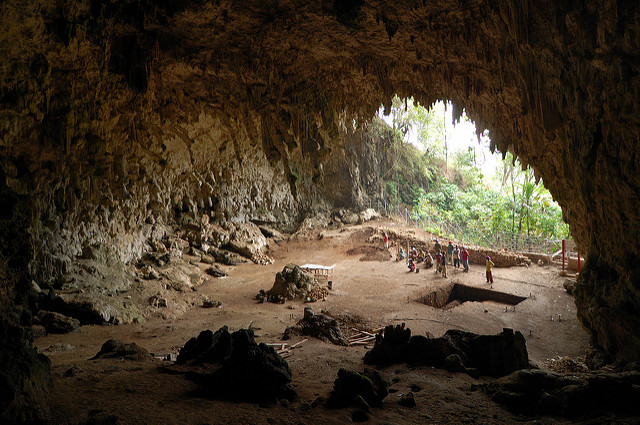 Evolution & Behaviour
Evolution & Behaviour
Homo floresiensis – little species, big mystery

A new kind of human, Homo floresiensis was a surprise discovery in 2003 by an Australian-Indonesian archaeological team who were trying to find the origins of the first Australians. Their focus was Liang Bua cave, on the island of Flores, Indonesia. Instead of finding modern human bones, they discovered something completely unprecedented. Deep in the excavation were bones representing a number of very different and very small individuals dated to between 100.000 and 60.000 years ago. These bones represent a new species and are named Homo floresiensis.
14 years on, and we know a lot about H. floresiensis. Individuals were short - about 1 meter tall. They had a small brain of only 426 cm3 (ours average 1300-1500cm3); had backward sloping foreheads, yet they possessed an expanded frontal cortex. This implies they could do some smart things such as plan, learn from mistakes, and hand down information from generation to generation. They lacked a chin, and instead had some ape-like structures inside the jaw. Wrist bones were also ape-like. The arms were relatively long and its shoulders were shrugged and hunched forward. This species walked upright. Its walk, however, would have been somewhat odd because its feet were quite long compared to its legs. It had to lift those feet up higher than we do, just to get ground clearance.
The mystery is - where does this species fit on the human evolutionary tree? Two hypotheses were originally proposed:
1)That H. floresiensis was the dwarfed descendant of a Homo erectus population that evolved under conditions of isolation on a small island (the "island rule").
The "island rule" stipulates that body size of mammals alters when a founder population reaches an island, becomes reproductively separated from its mainland origin group and faces an environment different from that of its mainland cousins. For example, a smaller body size could be expected as an evolutionary response to a limited food supply, and conversely a larger body size may occur in the absence of predation. H. erectus is the only known early hominin species from Indonesia. It is much larger than H. floresiensis and lived on Java 1.5 million years ago. There is no evidence for H. erectus on Flores, but then, Flores is relatively unknown archaeologically.
2)That H. floresiensis derived from an early lineage of Homo, similar to species that are known from around 2 million years ago in Africa, which were all relatively short. This would imply that an unknown founder population of archaic hominins arrived on Flores. Until recently we had no indication that a small hominin species had got to Flores, but in 2016 archaeologists at Mate Menge, about 74 kms from Liang Bua cave, discovered a H. floresiensis-like, but smaller, partial jaw of an adult individual, and some teeth, that are dated to 700,000 years ago.
We tested the two hypotheses by comparing characteristics of the cranium, jaws, dentition, shoulders, arms and legs of H. floresiensis with Australopithecus afarensis, A. africanus, A. sediba, H. habilis, H. ergaster, H. georgicus, H. naledi, H. erectus, H. floresiensis and H. sapiens. This is the first time that the H. floresiensis question had been addressed using a "whole-of-body" approach. Most previous work had focused on crania, mandibles and teeth.
Our results showed that H. floresiensis and H. habilis were closely related. H. habilis a species known only from Africa, dated to around 1.4-1.8 million years ago. H. floresiensis and H. habilis form "sister species" in our phylogenetic tree, which means that they most likely shared an immediate common ancestor. H. erectus, on the other hand, formed a sister species to the 1.5 million year old H. ergaster from East Africa. That is, H. floresiensis and H. erectus are not closely related at all and in additional tests we performed we found no statistical support for a close phylogenetic relationship between these two species.
H. floresiensis was a relict population that had descended from an unknown lineage of small, ~2 million year old hominins that lived half a world away. This represents an earlier diffusion of hominins out of Africa than we expected, and we now have the tantalizing prospect of one day finding H. floresiensis in Africa.
Original Article:
Argue D, Groves C, Lee M, Jungers W. The affinities of Homo floresiensis based on phylogenetic analyses of cranial, dental, and postcranial characters. Journal of Human Evolution. 2017;107:107-133. doi:10.1016/j.jhevol.2017.02.006.Next read: How did wild cats turn into our beloved domestic animals? by Magdalena Krajcarz , Maciej Krajcarz
Edited by:
Massimo Caine , Founder and Director
We thought you might like
How humans gave acne to the grapevine
Feb 28, 2015 in Evolution & Behaviour | 3.5 min read by Carlos J. Rivera-RiveraThe lingering effects of parental care and its role in evolutionary change
Jan 27, 2016 in Evolution & Behaviour | 4 min read by Rebecca KilnerLiving without mitochondria: the downfall of one textbook truth
Oct 3, 2016 in Evolution & Behaviour | 3.5 min read by Lukáš NovákFancy footwork: Darwin’s pigeons and the evolution of foot feathers
Jan 20, 2017 in Evolution & Behaviour | 3.5 min read by Eric DomyanMore from Evolution & Behaviour
Cicada emergence alters forest food webs
Jan 31, 2025 in Evolution & Behaviour | 3.5 min read by Martha Weiss , John LillSize does not matter: direct estimations of mutation rates in baleen whales
Jan 29, 2025 in Evolution & Behaviour | 4 min read by Marcos Suárez-MenéndezThe Claws and the Spear: New Evidence of Neanderthal-Cave Lion Interactions
Jan 22, 2025 in Evolution & Behaviour | 3.5 min read by Gabriele RussoA deep-sea spa: the key to the pearl octopus’ success
Jan 20, 2025 in Evolution & Behaviour | 3.5 min read by Jim BarryFeisty fish and birds with attitude: Why does evolution not lead to identical individuals?
Aug 31, 2024 in Evolution & Behaviour | 3 min read by Lukas Eigentler , Klaus Reinhold , David KikuchiEditor's picks
Trending now
Popular topics


